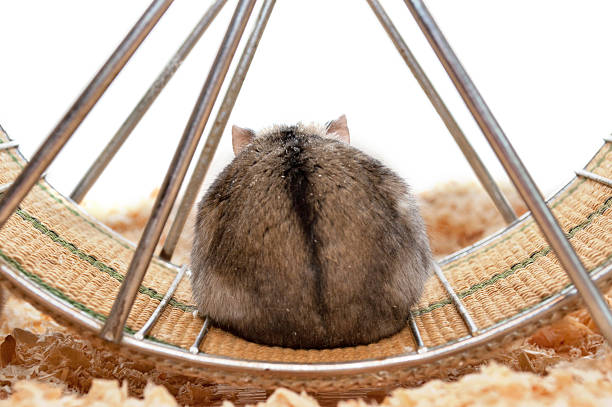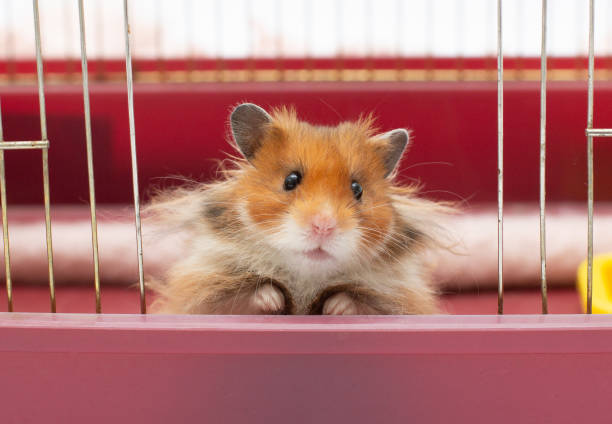Even before the hamster moves in, the home has to be prepared for the new roommate. But not only the furnishings, but also the location of the hamster home needs to be carefully considered. Read here what you absolutely have to pay attention to.
Before the hamster moves in, you must decide whether the hamster home should be a cage or a terrarium. In a cage, the bars should be horizontal. If the cage has a vertical grid, there is a risk that the rodent will become trapped between the bars. You have to consider the following special features in the cages of the different hamster breeds:
- Syrian hamsters: with a grid spacing of max. 12 mm, like this Petgard mouse and hamster cage*
- Chinese Striped Hamsters: Cage better suited than a terrarium as these hamsters like to climb the bars like this Petgard Mouse and Hamster Cage
- Roborowski dwarf hamster: A terrarium is better suited than a cage, as the tiny hamsters can easily break out through the bars of a cage. The wire mesh of the terrarium cover must not be too large, as with the Eugad 0035HT hamster cage
The right size for the hamster home

Whether in a cage or in a terrarium, a hamster needs a lot of space to run around. According to the latest research studies on hamster husbandry, the ideal floor space for the hamster home is at least one square meter. The following applies the bigger, the better! The minimum height should not be less than 50 cm.
Even if hamsters are not climbing animals, it does not hurt if you construct ramps, for example. There are many ways to do this, such as Trixie’s Natural Living Bridge
Another means of designing the cage is the use of so-called tube systems. After all, in the wild, hamsters also live underground in tunnels they have dug themselves. With a little manual skill, you could connect several cages with pipes, for example, plastic wastewater pipes from the hardware store. So you can offer the hamster the sleeping place, the feeding place, and the “sports studio” with running wheel and activity material in the different cages.
The basic needs of the hamster
In order to be able to properly prepare the hamster home, you need bedding made from wood shavings. This can be bought at any pet store. You will also need the following furnishings:
- Small houses like the Getzoo living labyrinth Leyla*
- Feeding bowls suitable for hamsters*
- Drinking bottles for hamsters*
- Impeller* in the right size
- Sand bath with sand suitable for hamsters*
In general, all of these items should not be made of plastic except for the hamster wheel. Hamsters are enthusiastic rodents. However, they can injure themselves or choke on the plastic splinters. The hamster house can be made of wood, but you can also use a hollowed-out coconut or a ceramic flower pot with a drainage hole. It should only be big enough for the hamster to store its supplies in.
Although the food can be distributed in the litter to give the hamster something to do, this makes it harder to control how much the hamster eats. In addition, a feeding bowl is more hygienic. This should be heavy and high enough so that the hamster neither knocks it over nor fills it with bedding. The fresh food should be offered in a separate feeding bowl. Even if the rodents absorb a lot of liquid from the fresh food, they still need fresh water every day. A water bottle with a ball cap works best.
A running wheel for the hamster

In the wild, hamsters sometimes cover enormous distances when they are looking for food. A research group from Bern has measured the distance that a hamster covers on its wheel in one night: on average over 5 kilometers! So the impeller is an important part of the cage setup. According to research results, it is neither harmful to health nor does it trigger addiction in hamsters. Quite the contrary, the rodents even develop reasonable handling of this “sports equipment”.
However, the hamster wheel should meet some criteria. These vary from breed to breed:
- Golden hamster: minimum diameter of 30 cm
- Chinese striped hamster: minimum diameter of 27 cm
- Campbell hamsters, Djungarian hamsters, and Roborovsky hamsters: minimum diameter of 25 cm
In any case, the hamster wheel should be closed on one side and open all the way to the other side to avoid pinching between the stand and the axle. The running surface should also be continuously closed. Hamster wheels with metal sprouts can be tied with a jute ribbon.
However, this is only the basic equipment of the hamster’s home. In order for the rodent to really feel comfortable, he should be offered other play and sporting opportunities. These can be, for example, ramps or tunnels, but also branches or twigs.